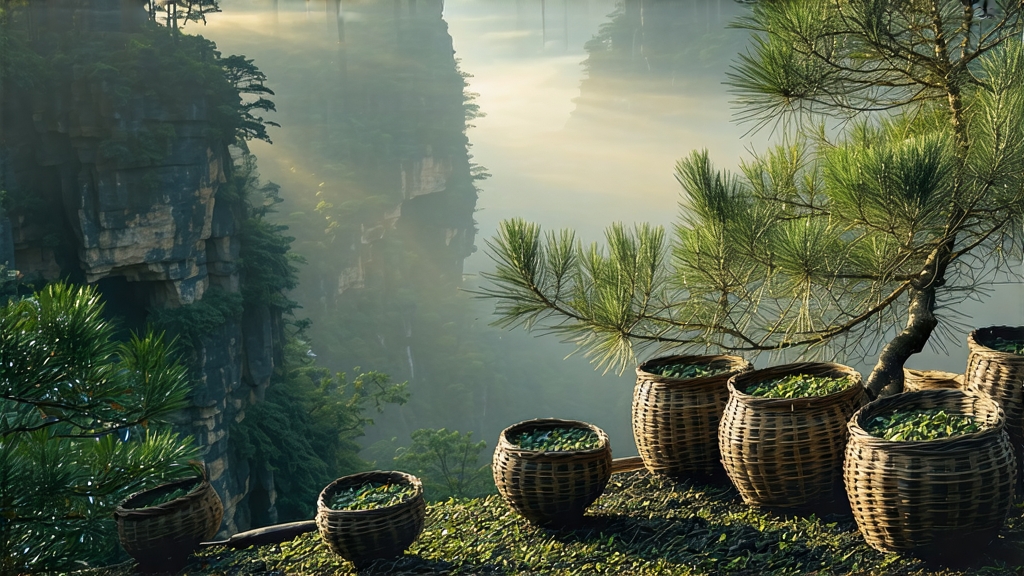
Ask most tea lovers to name China’s oldest black tea and the answer is the same: Lapsang Souchong. Born in the cool, mineral-rich folds of the Wuyi Mountains in northern Fujian, this leaf is celebrated not only for its campfire aroma but also for the pivotal role it played in launching the global black-tea trade. From the caravans of the Qing dynasty to the porcelain cups of Victorian London, Lapsang Souchong was the first “red tea” (hong cha) the West ever tasted, and its story is still written in every wisp of pine smoke that rises from a freshly opened tin.
History: a frontier leaf becomes world currency
Local legend fixes the birth year at 1646, when Qing troops forced tea farmers to speed up drying. In desperation the villagers dried fresh leaves over available pine fires, inadvertently creating a smoky leaf that Dutch traders later labelled “bohea.” By the early eighteenth century the East India Company was auctioning “Lapsang Souchong”—the term a corruption of the village name Zheng Shan Xiao Zhong—alongside silks and spices. The tea fetched higher prices than green tea in London, convincing British planters to transplant Chinese varieties to Assam and Darjeeling, thereby seeding the entire Indian black-tea industry. In other words, every breakfast blend in the world owes a quiet debt to a pine-smoked leaf from a canyon known as Tongmu.
Micro-terroir: why only Wuyi can birth true Zheng Shan
Authentic Lapsang Souchong comes from a 600–1,200 m micro-zone inside the Wuyi National Nature Reserve where mist traps humidity, temperature swings are dramatic, and the soil is a stony mix of weathered tuff and granite. These stresses slow leaf growth, concentrating amino acids and sugars that later balance the smoke. Regulations issued by the Fujian provincial government restrict the geographical indication to just 670 hectares surrounding the villages of Tongmu, Guadun, and Miaowan; anything produced outside this perimeter must be labelled “waishan” (outer mountain) and is considered a different commodity.
Cultivar and plucking standard
The traditional cultivar is Xiao Ye Zhong (“small-leaf seed”), a shrub whose narrow, olive-green leaves are rich in geraniol and linalool, precursors to fruity and floral aromatics. Only the tender single bud and first two leaves are plucked from late April to early May, before the monsoon arrives. A strict rule forbids picking after rain, because surface moisture would dilute the withering chemistry and carry undesirable “green” notes into the finished tea.
Craft: turning green leaf into smoky memory
The process is a six-act play performed within 24 hours.
- Outdoor withering: baskets of fresh leaf are laid on bamboo racks in shaded courtyards for 3–4 hours, softening cell walls and initiating enzymatic oxidation.
- Indoor withering: the leaf is moved to the second floor of wooden houses whose windows are cracked just enough to allow a draft; here it loses another 25 % moisture while absorbing the resinous scent of smouldering pine below.
- Rolling: once the leaf feels like supple leather, it is rolled for 30 minutes to rupture cells and release juices that will later oxidise into theaflavins and thearubigins.
- Oxidation: the twisted leaf is piled in shallow bamboo trays inside a humid room kept at 24 °C. For Lapsang Souchong oxidation is arrested earlier (around 80 %) than for most black teas, preserving a reddish-copper liquor rather than a deep brown.
- Smoking: the critical signature. Fresh pine logs (Pinus massoniana) are split, dried for six months, then lit in a sunken pit. The smouldering embers produce little flame but steady smoke that is channelled through brick flues under bamboo sieves laden with tea. The leaf is smoked for 6–8 hours, absorbing volatile phenols such as guaiacol and syringol that create the unmistakable aroma of cured bacon and pine sap.
- Firing: finally the tea is pan-fired at 90 °C to reduce moisture to 3 %, stabilising the smoke and locking in a long shelf life.
Two styles exist today. Traditional pine-smoked Lapsang carries a bold, assertive fragrance; a newer “unsmoked” or “